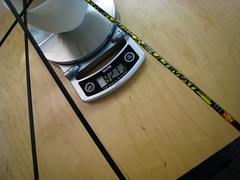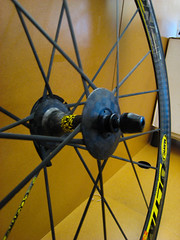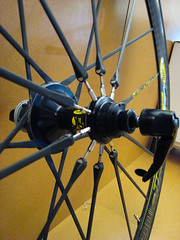Courtesy of the very nice folks at SRAM, and especially their media person, Michael Zellmann, I was able to get a chance to ride their new Force group of road components. The high-end component market has been dominated by Campagnolo and Shimano for the 20 years that I've been riding bikes -- in fact, SRAM's gruppo is the first full road group that's been released in that period of time.
Armed with a lovely Specialized Tarmac SL equipped with the Force components and Roval full-carbon clincher wheels, I hit the roads in Northern California to see if Force is a legitimate challenger to Shimano's Dura Ace and Campy's Record line.

The crankset is a lovely piece, wrapped in very pretty carbon fiber. The chainrings are shot-peened, and have a nice grey color to them. Although you can't see them, the bearings for the bottom bracket are outboard, similar to Dura Ace.
I had no compaints with the crank/bottom bracket combo. It was plenty stiff, certainly for the amount of power I can generate. There was no creaking or play in the bearings, and the build seemed very solid. Frankly, there's not a lot that can really go wrong here, and SRAM didn't make any mistakes.

One real problem I've face with my bike (equipped with Dura Ace) is getting it to shift well on a compact crankset. Especially on the way from the large to the small chainring, it's very prone to throwing the chain completely past the chainring, and onto my bottom bracket. Which sucks.
I was very impressed by the front shifting on the Force. There's one front mechanism that's used for either standard or compact chainrings -- but there's a clever way to lower it to make sure that the tolerance is right for the size you're running. Also, the cage is wide enough that there aren't any trim settings to mess with. You just get it to the right chainring, and forget it. All in all, a major upgrade for me.

In the back, shifting was equally good. There was a very solid feel -- some might argue inelegant. With Dura Ace and Record, you sometimes aren't quite sure if your shift has finished; by the time you're trying to sense it, it's already over. But with Force, there's a very positive action, almost a THUNK, that lets you know for sure. Some people might not care for it, but I like it.
The other nice thing is how unfussy it seems. I feel like after (or during) most rides, I'm tweaking my cables just a bit, trying to insure that upshifts and downshifts happen with the same speed, and equally smoothly. After adjusting the rear once, I didn't have to futz with it at all, even after swapping out the cassettes, which I have a hard time imagining with Dura Ace. One of the things that SRAM is touting in their marketing is that each shift requires the same amount of cable to be pulled (unlike the other groups), and from my testing, that consistent mechanical action does show some benefits.
Not pictured here is the SRAM cassette -- I had to wuss out and put on a 25 in back for the hills around here. SRAM is going to be shipping an 11-26 rear cassette, which is great news, I think. Perfect for compacts in tough terrain like NoCal.

Here's the cockpit. Like Campy Record, all the cables are under the handlebar tape, leading to a nice, clean look. It's a little hard to tell from this shot, but the left and right hoods are sculpted differently, and are canted slightly to fit the hand -- they were comfortable while on the hoods, and provided a good platform on top. They're a little smaller than the Shimano hoods, a similar size to Campy.

In this closeup of the left brake lever, you can see the cant I was talking about.
The shifting on Force uses what SRAM called Double Tap. A small inward movement of the lever downshifs to a higher gear, a longer throw upshifts into a smaller gear. It's was actually completely intuitive -- imagine using the upshift lever on Record for all the shifts, but just tapping is slightly to get bigger gears. Seriously, it sounds much, much more complicated than it rides, and I didn't find myself having to think about it at all, even after just a few miles.

I found the brakes to be really nice looking, especially the cutout in the top arm. Modulation was very good, and the action at the lever was smooth and controlled. Stopping power was harder to evaluate for me, as I was riding a test bike with carbon rims, and therefore had cork pads, and not the standard pad that SRAM ships for most wheels.

Another look at the calipers, this time up front.
Overall, I was really impressed by Force. SRAM's done a ton of work and research to get this right, and it's a hugely ambitious undertaking. It's certainly right there with the top of the line from the big two, and I'll definitely consider it when I need new gear.














